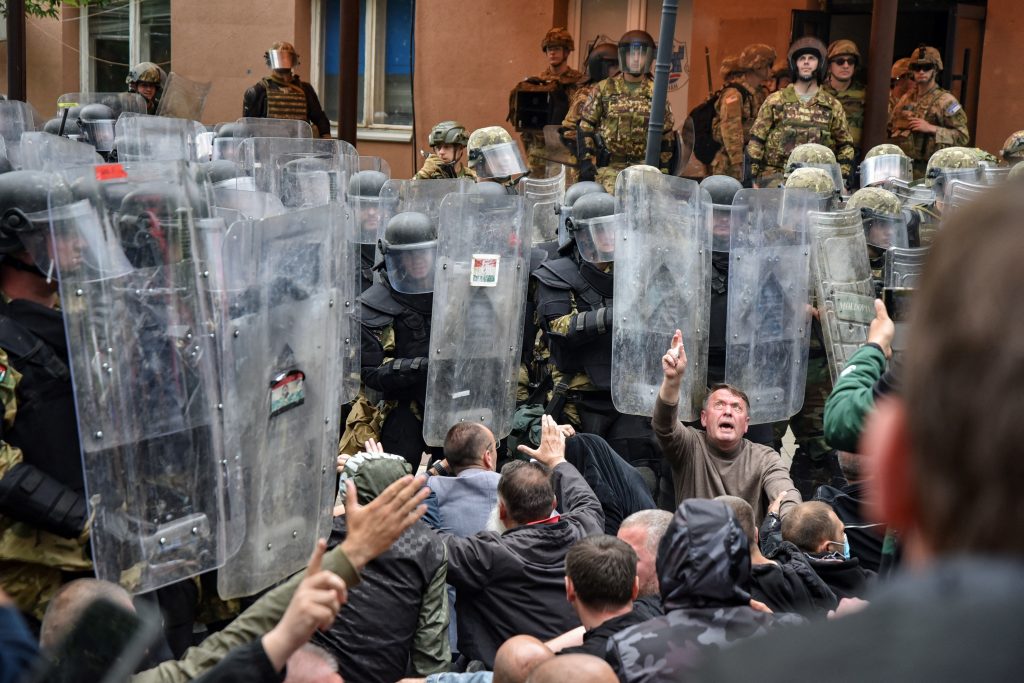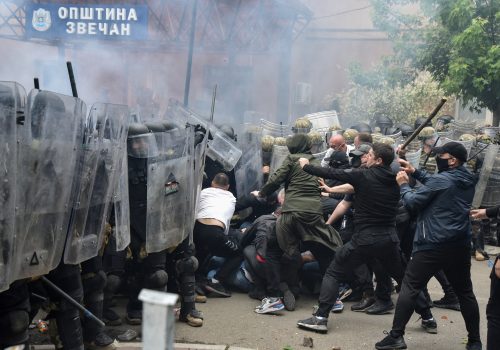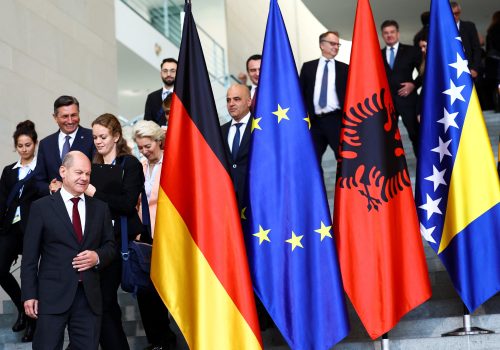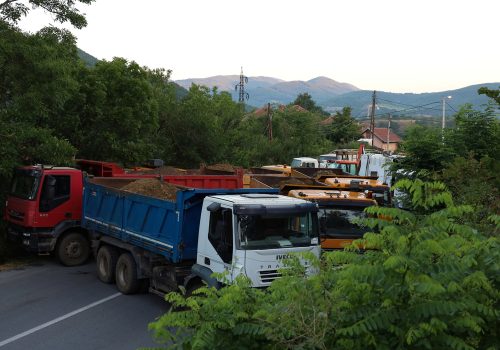The conflict between Kosovo and Serbia is concentrated in Kosovo’s north—about one thousand square kilometers, around 10 percent of Kosovo’s territory, inhabited by a predominantly Serb population of around fifty thousand, which is about 40 percent of the Serb population in Kosovo and about 3 percent of Kosovo’s total population. This tiny piece of land has been a major source of tensions between Kosovo’s Albanians and Serbs and between Pristina and Belgrade for over two decades now. Many models to resolve it have been tried and failed. An agreement in 2013 in Brussels enabled a soft integration, but these gains were reversed last year when thousands of Serbs quit their jobs—including police officers and judges—as part of a wider Serb boycott of Kosovo’s institutions. Serbia’s and Kosovo’s leaders also tried, unsuccessfully, a few years ago a “territory solution” centered on the north’s future.
Kosovo’s leaders now insist on the north’s unconditional integration. Kosovo Serbs equate such integration with subordination, insisting instead on autonomy in local affairs as a precondition for integration, a position Belgrade supports and the international community sympathizes with.
The new stalemate is untenable and, if left unchecked, could spark a series of confrontations between Kosovo and Serbia and between Kosovo’s authorities and local Serbs.
There are at least four major sources of tensions that need attention.
First, small incidents could lead to uncontrollable violence. The relations between the predominantly Albanian police and local Serb population in the north are tense. The Serbs say they feel intimidated by the large and monoethnic police presence—an overwhelming majority of police are Albanian in a territory with over 90 percent Serbs. A small incident could escalate this tense relationship into widespread violence.
Second, Serbs in the north feel disenfranchised. Though constituting an overwhelming Serb majority, the four municipalities in the north are now run by Albanian mayors elected in an election the Serbs boycotted, with a total turnout of below 4 percent. Furthermore, thousands of Serbs resigned last year from Kosovo’s institutions. Though Albanians and Serbs disagree over the reasons behind the boycott—Albanians say Belgrade orchestrated it while Serbs say Kosovo’s discriminatory policies pushed them out—Serbs’ feelings of disenfranchisement could undermine diplomatic efforts to reintegrate the region. This feeling could also fuel resentment that could subsequently drive active Serb civil disobedience, which could escalate into violence. Though not in a position to secede, Serbs in the north have the capacity to derail Pristina’s efforts to establish its authority there, as demonstrated this summer by their boycott of Kosovo’s local elections and institutions and their violent demonstrations.
Third, tensions in and over the north have triggered a new wave of nationalism in Serbia and Kosovo that could further intensify, jeopardizing not only the gains of the past decade but also undermining future peace efforts. So far, the leaders of both countries have had control over this radicalism. But if nationalism rises to uncontrollable levels, the leaders will likely feel compelled to respond to increasingly extreme public expectations by undertaking risky actions. Nationalism and resentment combined could guide Kosovo’s and Serbia’s governments and publics towards inevitable confrontation.
Fourth, Kosovo might take more steps to establish its control in the north that could further alienate the Serb population. Pristina seems intent on removing from public premises the Serbian-funded institutions that offer services to the Serb population, such as pensions and salaries for thousands of teachers and doctors employed in the Serbian-funded system
The way forward
Kosovo and Serbia could take immediate action to ease the tensions and create the conditions for reintegration of the Serbs in Kosovo’s north. The key will be for Kosovo and Serbia to delink the north’s integration from the seemingly intractable status dispute—consider the north’s integration as a non-status issue—and commit to implement all the agreements on Serb integration by the end of the year. This includes implementing the Association/Community of the Serb-Majority Municipalities, a proposal for greater Kosovo Serb control on local affairs in the ten Serb-majority municipalities first agreed to between Belgrade and Pristina as part of the 2013 Brussels Agreement.
Kosovo should take the initiative, as its own citizens and territory are at stake. Kosovo should not consider eventual additional rights for the Serbs through the Association/Community as concessions to Serbia, but as part of an integrationist policy to accommodate a portion of its own citizens who for various reasons are reluctant to integrate into a state their mother country, Serbia, does not recognize. Serbia, in turn, should unequivocally support the Serb reintegration into Kosovo’s institutions. Serbia should not consider this a concession to Kosovo, but as a way to improve the position of this rather small and poor Serb community caught in the crossfire. Serbia and Kosovo can have their confrontations on other fronts, and they have plenty. And the Kosovo Serb leadership should operate autonomously of Belgrade on local affairs.
How might this be accomplished? The parties should first agree on new local elections in the north, with Kosovo Serbs committing to participate. Simultaneously, Kosovo should draft a statute for the Association/Community to be formed as soon as the new mayors are voted into office. Another important step is facilitating the return of the thousands of employees who quit—especially the police—to their workplaces.
Though a controversial policy, if formed in good faith, the Association/Community would not lead to the north’s partition, as Albanians fear, but could instead serve as a path to Serbs’ sustainable integration. A permanent minority in central institutions—all top positions are held by Albanians—the Serbs want a bigger say in local affairs in municipalities where they constitute a majority. Specifically, the Serbs want Pristina to grant them more autonomy in local economic development, urban planning, education, and healthcare. Such demands might be considered normal in developed democracies, but this is not the case in Kosovo, a country with deep ethnic divisions where even trivial transfers of power appear to have high stakes. Albanians could, for instance, offer the Serbs in the north a significant national position, such as parliament speaker—an integrationist technique frequently applied in other countries with similar ethnic challenges—to make them feel like a stakeholder in Kosovo’s future.
To aid Serb integration, all Kosovo’s Albanian political parties need to support the formation of the Association/Community. No party—no matter how strong it is—can afford to form it alone given the likely painful political costs. Not because the Association/Community is necessarily bad for Kosovo—in fact, it would phase out the Serbian institutions with more than ten thousand employees and facilitate their integration into Kosovo’s system—but because most Albanians seem to believe it is. Therefore, bipartisanship is a must. And it shouldn’t be difficult. After all, all parties agreed to the Association/Community in one form or another during the decade-long negotiations with Serbia. Furthermore, Kosovo’s parliament has already adopted this piece of policy. Serb integration is a key test of the ability of the Albanian political leadership—both governing and opposition parties—to build a liberal democratic state with the capacity to find a balance that satisfies both the majority and minority communities.
For such an integrationist approach to work, Kosovo Prime Minister Albin Kurti and Serbian President Aleksandar Vucic would have to transform their belligerent interactions into a working relationship. Some reconciliatory messages have begun to gain ground. Kurti has agreed to offer more self-management to the Serbs, reversing his previous position. Meanwhile, Vucic has recognized that peace with Albanians is beneficial for Serbia. But in general, the leaders continue to speak in ways that produce more ire than reconciliation. Of course, it will take a shift in attitude both in the leaders and in the broader public. Though public opposition to normalization of relations is widespread, it is shallow. It is not based on fundamental political positions or ideological views.
So, public sentiments could shift quickly toward greater support for reconciliation if leaders in Belgrade and Pristina advocate for it. As European Union-led talks between Serbia and Kosovo continue this week, it is imperative that Kurti and Vucic take the necessary steps to reduce tensions and facilitate Kosovo Serb reintegration.
Shpetim Gashi is vice president of the Council for Inclusive Governance.
Milica Andric Rakic is program manager at the New Social Initiative.
Further reading
Fri, Jun 2, 2023
Five questions (and expert answers) about the recent clashes in Kosovo
New Atlanticist By
Protests this week in Kosovo when local officials took office resulted in injuries to NATO peacekeeping troops—and in fears of a further escalation of violence. Atlantic Council experts answer the critical questions.
Thu, Nov 3, 2022
Germany steps up in the Western Balkans. Will the EU follow its lead?
New Atlanticist By Damir Marusic, Maja Piscevic, Jörn Fleck
Thursday's Western Balkans summit is a sign of momentum for regional economic cooperation and integration—and it couldn't come at a more important time.
Mon, Aug 1, 2022
Former Kosovo foreign minister: How to stop Serbia spat from spiraling out of control
New Atlanticist By
A border flare-up between local Serbs and Kosovars is a reminder that Brussels and Washington must change their formula to solve crises, writes Kosovo's former top diplomat.
Image: Local Kosovo Serb protesters sit on the ground in front of NATO Kosovo Force (KFOR) soldiers in the town of Zvecan, Kosovo, May 29, 2023. REUTERS/Laura Hasani



